
10 Must-Read Histories of the Palestine-Israel Conflict
On the Anniversary of the Balfour Declaration, Ian Black Offers Some Definitive Histories
November 2 marks the centenary of the Balfour Declaration, when the British government famously promised to establish a Jewish “national home” in Palestine. A century of conflict in Palestine/Israel has produced a vast and ever growing historical literature in English, as well as in Arabic and Hebrew. Conflicting or irreconcilable narratives mean that works which tell the story of, and from, both sides, are rare. Views of fundamental issues like the legitimacy of Zionism or the Palestinians’ right to resistance inevitably color the interpretation of key events from Balfour to the 2014 war over the Gaza Strip. Perceptions can still be polarized about Israel’s war of independence and the Palestinian nakba (catastrophe) of 1948, the 1967 war, and the character of the occupation that persists 50 years later. Well-known books, especially by Israel’s “new” historians, have made a big impact on knowledge of the formative pre-state period. Here are ten others which in different ways and at different times have made a significant contribution to illuminating this unending story.
*
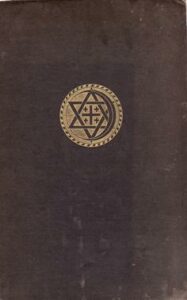
Ronald Storrs, Orientations
Storrs was the first British military governor of Jerusalem after the Ottoman surrender in December 1917. His memoir is elegantly if pretentiously written. It reflects contemporary colonialist assumptions about Arabs and Jews, the innate authority and arrogance of the world’s largest empire and the author’s mounting frustration as the confrontation unfolded in its earliest days. Storrs was in Palestine at the time of the Balfour Declaration and in the early Mandate years. Perhaps his most memorable line, as resentment and tensions mounted, was how “two hours of Arab grievances drive me into the synagogue, while after an intense course of Zionist propaganda I am prepared to embrace Islam.”
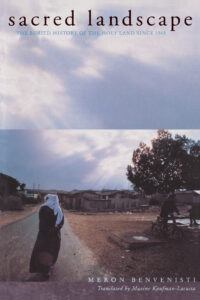
Meron Benvenisti, Sacred Landscape: The Buried History of the Holy Land since 1948
Benvenisti, who was born in Palestine in 1934, is one of the most astute Israeli Jewish writers about the conflict. His father was a geographer who instilled a deep love for the country in him. Rather than ignoring the Palestinians, as many Jews do, he focuses intensely on them and especially on how the landscape of his youth was transformed as Arab villages were destroyed or renamed in Hebrew. The “signposts of memory” that he identifies are markers of a bitterly contested history. Benvenisti served as deputy mayor of Jerusalem after 1967. He was also an early proponent of the argument—from the 1980s onwards—that the occupation was irreversible and a two-state solution unachievable. He was attacked for this, but events in recent years seem to be proving him right.
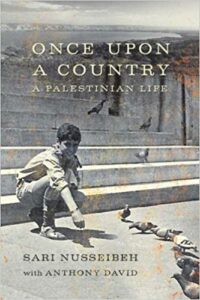
Sari Nusseibeh, Once Upon a Country: A Palestinian Life
This autobiography is by the son of a patrician Jerusalem Arab family. He grew up in the 1950s on the “seam” between the Jordanian and Israeli sectors of the then divided city and describes the experience of encountering Israelis for the first time after 1967, even volunteering on a kibbutz. The Oxford-educated philosopher taught at Bir Zeit University in the West Bank, where resistance to occupation was the norm. He played an important behind-the-scenes role in the first intifada, drafting leaflets that provided strategic guidance and linked local activists to the PLO leadership abroad. This perceptive and humanistic book exudes optimism which today often seems unwarranted. He quotes his father as saying: “Rubble often makes the best building materials.”

Neil Caplan, The Israel-Palestine Conflict: Contested Histories
Part of a series called “Contesting the Past,” this even-handed study is by a Canadian academic who has spent his whole career researching and teaching the history of the Israel-Palestine conflict. Caplan provides a brisk and balanced account of it. But he also manoeuvers deftly between and above the Arab and Zionist narratives and helpfully defines the main historiographical disputes that keep scholars arguing—included loaded terminology like “terrorism” and “resistance.” It looks at the core arguments “that seem to deadlock protagonists and historians alike,” explaining cogently why the conflict has not yet been resolved—and why it may never be.

Ghada Karmi, In Search of Fatima: A Palestinian Story
This is the story of a Palestinian who was uprooted from her family home as a child in Jerusalem and has spent her adult life promoting her people’s cause. Karmi’s account of the Nakba (catastrophe) vividly captures the tension and fear of the first months of 1948 when the Haganah went onto the offensive, overcoming poorly organized Palestinian forces and de-populated the Arab neighborhoods on the western side of the city. Politics and war dominated her youth, but Karmi memorably describes the pain of losing contact with her dog—as well as the Fatima of the title, the faithful family servant—and living her life as a refugee.

Shira N. Robinson, Citizen Strangers: Palestinians and the Birth of Israel’s Liberal Settler State
In recent years the concept of settler colonialism has become a fashionable if controversial way of understanding the Palestine-Israel conflict. It draws parallels between the Zionist movement and European settlers in North America, Australia and elsewhere who built their own societies and economies while excluding, dispossessing or eliminating the natives. There are some obvious differences. But Jewish immigrants who were fleeing anti-Semitism were also settlers. Robinson uses that framework to study the Palestinian minority left in Israel after 1948 and the paradox of their being second-class citizens living under a military government, but with democratic rights, and in a Jewish state surrounded by Arab enemies. Superbly researched using archival and a wealth of other sources in Arabic and Hebrew.

Shlomo Ben-Ami, Scars of War Wounds of Peace: The Israeli-Arab Tragedy
Ben-Ami, a historian by training, served in the government of Ehud Barak, Israel’s Labour prime minister from 1999-2001. His book is an extended essay on the conflict from the 1930s onwards. It does not offer a conventional chronological account so the reader needs to be familiar with the story. But his interpretations are perceptive and interesting— from his judgement of the inevitability of the Arab-Zionist confrontation to fascinating details about the gap between the two sides in the run-up to the abortive Camp David summit in 2000, the prelude to the second intifada. “Jews and Arabs have a special reverence for the past,” he writes, “but they are also fatally trapped in its lies.”
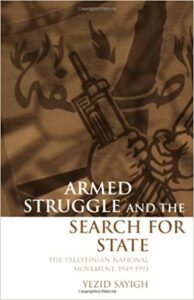
Yezid Sayigh, Armed Struggle and the Search for State: The Palestinian National Movement 1949-1993
This is still the definitive account of the Palestinian national movement from 1949-1993, more than 20 years after it was published. That movement, now demoralized and flagging, is still in search of a state. Based on a mass of internal documents and interviews with PLO leaders, it is a monumental work of research that gives the perspective from inside in a way that probably only a Palestinian scholar could do. It describes political and ideological changes as well as complex relations with Arab governments. It shows too how spectacular terrorist attacks like the Munch Olympics massacre in 1972 were defended by Yasser Arafat but abandoned because they offset the diplomatic gains the organization was starting to make.

Menachem Klein, Lives in Common: Arabs and Jews in Jerusalem Jaffa and Hebron
Jews lived in Ottoman Palestine long before the Zionist movement was born in the late 19th century, although their story has been eclipsed by nationalist narratives on both sides which project a zero-sum conflict back in time. Klein is a political scientist and peace activist. His focus is on native Arabic-speaking Jews who lived alongside Muslims and Christians in Jerusalem, Jaffa and Hebron at the turn of the 20th century. He draws on autobiographies, diaries and the Hebrew and Arabic press to recreate a lost world of social intercourse and religious tolerance. The book fast forwards to the uneasy and often hostile relationships between Arabs and Jews in the very different circumstances of those cities today. It is telling that it was criticized by some as an expression of nostalgia for an idealized or irretrievable past or wishful thinking about an unattainable future.
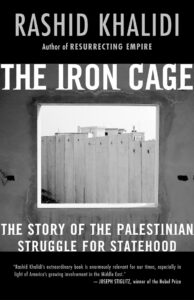
Rashid Khalidi, The Iron Cage: The Story of the Palestinian Struggle for Statehood
Khalidi’s argument goes to heart of the injustice experienced by the Palestinians. He shows that the structure of the Mandate was skewed against them by Britain’s commitment to the Zionist project—thus the image of an ‘iron cage.’ This imbalance was constant: the UN partition decision of November 1947 gave the Jews, then one-third of the population, half of the territory of Palestine. That was rejected by the Arabs. It is necessary, he shows, to go beyond the language of colonialism because Zionism simultaneously oppressed the Palestinians and meant national liberation for the Jews—and has produced a new people speaking their own language, living in a country called Israel. It is not a question of whether Arabs or anyone else find that paradox palatable or just. It is that this important story doesn’t make any sense without grasping it.
Ian Black
Ian Black is the author of Enemies and Neighbors: Arabs and Jews in Palestine and Israel, 1917-2017. He joined the Middle East Centre at the London School of Economics as visiting senior fellow in August 2016. He has been the Middle East editor, diplomatic editor, and European editor for the Guardian. He has also written for the Economist and the Washington Post, among other publications. He coauthored Israel's Secret Wars, wrote the introduction to The Arab Spring: Revolution, Rebellion and a New World Order, and contributed to the Encyclopedia of the Modern Middle East and North Africa. He has an MA in history and political science from the University of Cambridge and a PhD in government from LSE. He lives in London.



















